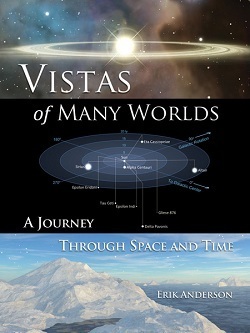Paul Gilster's Blog, page 236
November 30, 2012
Images of Exoplanetary Journeys
Stretch out your time horizons and interstellar travel gets a bit easier. If 4.3 light years seems too immense a distance to reach Alpha Centauri, we can wait about 28,000 years, when the distance between us will have closed to 3.2 light years. As it turns out, Alpha Centauri is moving in a galactic orbit far different from the Sun’s. As we weave through the Milky Way in coming millennia, we’re in the midst of a close pass from a stellar system that will never be this close again. A few million years ago Alpha Centauri would not have been visible to the naked eye.
The great galactic pinball machine is in constant motion. Epsilon Indi, a slightly orange star about an eighth as luminous as the Sun and orbited by a pair of brown dwarfs, is currently 11.8 light years out, but it’s moving 90 kilometers per second relative to the Sun. In about 17,000 years, it will close to 10.6 light years before beginning to recede. Project Ozma target Tau Ceti, now 11.9 light years from our system, has a highly eccentric galactic orbit that, on its current inbound leg, will take it to within the same 10.6 light years if we can wait the necessary 43,000 years.
And here’s an interesting one I almost forgot to list, though its close pass may be the most intriguing of all. Gliese 710 is currently 64 light years away in the constellation Serpens. We have to wait a bit on this one, but the orange star, now at magnitude 9.7, will in 1.4 million years move within 50,000 AU of the Sun. That puts it close enough that it should interact with the Oort Cloud, perhaps perturbing comets there or sending comets from its own cometary cloud into our system. In any case, what a close-in target for future interstellar explorers!
I’m pulling all this from Erik Anderson’s new book Vistas of Many Worlds, whose subtitle — ‘A Journey Through Space and Time’ — is a bit deceptive, for the book actually contains four journeys. The first takes us on a tour of ten stars within 20 light years of the Sun, with full-page artwork on every other page and finder charts that diagram the stars in each illustration. The second tour moves through time and traces the stars of an evolving Earth through text and images. Itinerary three is a montage of scenes from known exoplanets, while the fourth tour takes us through a sequence of young Earth-like worlds as they develop.
Anderson’s text is absorbing — he’s a good writer with a knack for hitting the right note — but the artwork steals the show on many of these pages, for he’s been meticulous at recreating the sky as it would appear from other star systems. It becomes easy to track the Sun against the background of alien constellations. Thus a spectacular view of the pulsar planet PSR B1257+12 C shows our Sun lost among the brighter stars Canopus and Spica, with Rigel and Betelgeuse also prominent. The gorgeous sky above an icy ocean on a planet circling Delta Pavonis shows the Sun between Alpha Centauri and Eta Cassiopeiae. Stellar motion over time and the perspectives thus created from worlds much like our own are a major theme of this book.
From Epsilon Eridani, as seen in the image below, the Sun is a bright orb seen through the protoplanetary disk at about the 4 o’clock position below the bright central star.

Image: The nearby orange dwarf star Epsilon Eridani reveals its circumstellar debris disks in this close-up perspective. Epsilon Eridani is only several hundred million years old and perhaps resembles the state of our own solar system during its early, formative years. Credit: Erik Anderson.
Vistas of Many Worlds assumes a basic background in astronomical concepts, but I think even younger readers will be caught up in the wonder of imagined scenes around planets we’re now discovering, which is why I’m buying a copy for my star-crazed grandson for Christmas. He’ll enjoy the movement through time as well as space. In one memorable scene, Anderson depicts a flock of ancient birds flying through a mountain pass 4.8 million years ago. At that time, the star Theta Columbae, today 720 light years away, was just seven light years out, outshining Venus and dominating the sunset skies of Anderson’s imagined landscape.
And what mysteries does the future hold? The end of the interglacial period is depicted in a scene Anderson sets 50,000 years from now, showing a futuristic observation station on the west coast of an ice-choked Canada. The frigid landscape and starfield above set the author speculating on how our descendants will see their options:
Will the inhabitants of a re-glaciating Earth seek refuge elsewhere? Alpha Centauri, our nearest celestial neighbor, has in all this time migrated out of the southern skies to the celestial equator, where it can be sighted from locations throughout the entire globe. It seems to beckon humanity to the stars.
And there, tagged by the star-finder chart and brightly shining on the facing image, is the Alpha Centauri system, now moving inexorably farther from our Sun but still a major marker in the night sky. Planet hunter Greg Laughlin has often commented on how satisfying it is that we have this intriguing stellar duo with accompanying red dwarf so relatively near to us as we begin the great exoplanet detection effort. We’re beginning to answer the question of planets around Alpha Centauri, though much work lies ahead. Perhaps some of that work will be accomplished by scientists who, in their younger years, were energized by the text and images of books like this one.






November 29, 2012
Tracking Changes in Titan’s Atmosphere
Even as New Horizons continues to push toward Pluto, now just past the halfway point between the orbits of Uranus and Neptune, we’re continuing to get excellent data from the much closer Cassini spacecraft around Saturn. Cassini’s composite infrared spectrometer (CIRS) is probing the circulation and chemistry of Titan’s atmosphere, tracking how gases like benzene and hydrogen cyanide are distributed and affected by changes in temperature and circulation. We’re getting a closeup view of how chemistry and atmospheric circulation modify climate on the distant moon, information that shows a good deal of change over a short period of time.
The latest from Cassini, written up in a paper just published in Nature, involves a shift in seasonal sunlight that is apparently tied to the reversal in circulation around the moon’s south pole. Earlier in the mission the air here was rising. Now there is strong evidence for sinking air. Nick Teanby (University of Bristol, UK) notes how quickly the transition has occurred given the fact that Titan’s year is the equivalent of nearly 30 Earth years, and changes here generally occur slowly. Fortunately, Cassini is in the right position to see the changes in progress.
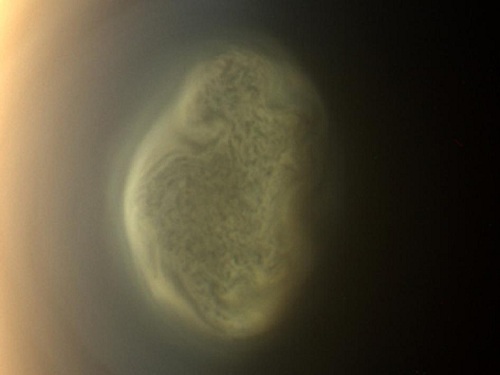
Image: This true color image captured by NASA’S Cassini spacecraft before a distant flyby of Saturn’s moon Titan on June 27, 2012, shows a south polar vortex, or a mass of swirling gas around the pole in the atmosphere of the moon. The south pole of Titan (3,200 miles, or 5,150 kilometers, across) is near the center of the view. NASA/JPL-Caltech/Space Science Institute.
In Cassini’s first years at Saturn, Titan’s north pole was associated with a high-altitude hot spot at a time of northern winter. A visible ‘hood’ of dense high altitude haze remained lit by sunlight even though much of the northern latitudes remained dark. As the southern hemisphere moved into autumn and began to tilt away from the Sun, the north pole hot spot began to disappear, while similar features — evidently induced by the compression of sinking air above the pole — started showing up at the south pole. The reversal from uplift to sinking air evidently occurred in a period of six months around the equinox of August 2009, when the Sun was directly over Titan’s equator. Within two years of the reversal, some of the gases CIRS tracks had increased 100-fold.
“Next, we would expect to see the vortex over the south pole build up,” said Mike Flasar, the CIRS principal investigator at NASA’s Goddard Space Flight Center in Greenbelt, Md. “As that happens, one question is whether the south winter pole will be the identical twin of the north winter pole, or will it have a distinct personality? The most important thing is to be able to keep watching as these changes happen.”
The story involves more than changes in Titan’s vertical winds. The CIRS instrument also found that complex chemicals are being produced at altitudes up to 600 kilometers above the surface, showing us that atmospheric circulation extends a good deal higher than expected. In fact, complex chemistry and vertical movement in the atmosphere occur above the haze layer first detected by the Voyager spacecraft. What had been thought to be a ‘detached’ layer of haze may actually be a transformational area where small haze particles combine before descending deeper into the atmosphere, where they produce the orange color characteristic of the moon.
The paper is Teanby et al., “Active upper-atmosphere chemistry and dynamics from polar circulation reversal on Titan,” Nature Vol. 491 No. 7426 — I’ll have a link to the abstract when Nature‘s servers, currently down, get back online. More in this JPL news release.






November 28, 2012
On Debris Disks and Super-Earths
The red dwarf Gliese 581 continues to draw the eye, whether or not the putative world Gl 581 g is there or not. The latter, whose existence has been the subject of controversy, would occupy a tantalizing place in its star’s habitable zone, though in some models the planet Gl 581 d might also skirt the outer edge of the HZ. Now we have interesting new work from the European Space Agency’s Herschel space observatory announcing that Gl 581, along with the G-class star 61 Vir, another nearby planetary system, shows the the signature of cold dust at -200 degrees Celsius.
It’s an abundant signature, too, meaning that both these systems must have ten times the number of comets found in our own Solar System’s Kuiper Belt. The two papers on this work grow out of a program called, fittingly, DEBRIS (Disc Emission via a Bias-free Reconnaissance in the Infrared/Sub-mm). What the researchers working these data are suggesting is that the lack of a large gas giant in the two systems may relate to the dense debris cloud. Instead of an era of heavy bombardment triggered by gas giants disrupting the Kuiper Belt, as occurred in our system, these stars may have experienced a much gentler inflow of volatiles. Thus Mark Wyatt (University of Cambridge), lead author of the paper on 61 Vir:
“The new observations are giving us a clue: they’re saying that in the Solar System we have giant planets and a relatively sparse Kuiper Belt, but systems with only low-mass planets often have much denser Kuiper belts… We think that may be because the absence of a Jupiter in the low-mass planet systems allows them to avoid a dramatic heavy bombardment event, and instead experience a gradual rain of comets over billions of years.”
Have a look at this Herschel image showing the situation around Gl 581:
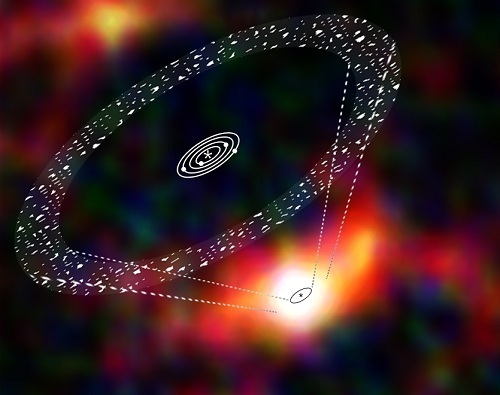
Image: An expanded diagram of the debris disc and planets around the star known as Gliese 581, superimposed on a composite Herschel image assembled from separate observations made with its PhotoArray Camera and Spectrometer (PACS) at 70, 100 and 160 micrometre wavelengths. The white region in the lower centre of the image is the emission that originates almost entirely from the disc, with only a small contribution from the unseen Gliese 581. The line drawing superimposed on the Herschel image gives a schematic representation of the location and orientation of the star, planets and disc, albeit not to scale. The black oval outline sketched onto the Herschel data represents the innermost boundary of the debris disc; the approximate location of the outermost boundary is represented by the outer set of dashed lines. Credit: ESA/AOES.
An older star like Gl 581 would have had two billion years or so for a substantial amount of water to be delivered to the inner system and, of course, to any potentially habitable worlds that reside there. What we now believe about the planets circling Gl 581 is that they have masses between 2 and 15 times that of the Earth, all located within 0.22 AU of the star, while the debris disk extends from 25 AU to 60 AU. A Neptune-class world further out, however, is a possibility. The researchers believe the large amount of dust Herschel has detected must be the result of cometary collisions, which could be triggered by a planet — perhaps about as large as the close-in planets — orbiting near the debris disk.
So we are looking at larger debris disks around systems where there is no Jupiter-class planet, and far less dense disks around stars where large gas giants are found. The paper on Gl 581 adds:
It is intriguing that, in our current analysis of the DEBRIS sample of 89 M-stars, the only debris disk confidently detected around a mature M-star also happens to be around the only star known to have low mass planets. This could mean that the correlation between low-mass planets and debris disks recently found for G-stars by Wyatt et al. (2012) also applies to M-stars. Then, the high fraction (∼ 25%) of M-stars known to host low mass planets in the radial velocity and Kepler observations should make debris disks relatively common around them. If these disks have not been detected yet, it may be because searches have simply not been deep enough, or because the disk around GJ 581 is the brightest owing to some intrinsic properties ; for example hosting a multiple planetary system.
Modeling of the debris disk around the G-class star 61 Vir shows that the dust extends from 30 AU to at least 100 AU. The two planets known to orbit the star have masses between 5 and 18 times that of the Earth, and are located within 0.22 AU. The paper on 61 Vir summarizes the situation with regard to G-class stars:
There is likely little interaction between the disk and the known planets, which are at < 0.5AU. The lack of planetesimals in the < 30AU region could be explained by the existence of planets in this region, but the depletion can also be explained by collisional erosion... Considering a sample of the nearest 60 G stars there is an emerging trend that stars which, like 61 Vir, only have low-mass planets, are more likely to have detectable debris... We attribute this trend to the fact that the formation processes that make low-mass planets are likely to also result in large quantities of distant debris.
The papers are Wyatt et al., “Herschel imaging of 61 Vir: implications for the prevalence of debris in low-mass planetary systems,” in press at Monthly Notices of the Royal Astronomical Society (preprint), and Lestrade et al., “A DEBRIS Disk Around The Planet Hosting M-star GJ581 Spatially Resolved with Herschel,” accepted by Astronomy and Astrophysics (preprint).






November 27, 2012
Life Around Cooling Stars
Red dwarfs offer fascinating astrobiological speculation, allowing us to ponder whether flare activity or tidal lock could be the game-changer that prevents life from developing around them. We have much to learn on that score, but new work from Rory Barnes (University of Washington) and René Heller (Leibniz Institute for Astrophysics, Potsdam) looks beyond red dwarfs to brown and white dwarfs and their own prospects for life. The prognosis: Poor. Planets around these objects, the researchers say, would have an early history that could remove surface water.
The problem is nuclear burning and the lack thereof. Yes, both brown and white dwarfs could support a habitable zone, but what sets them apart from red dwarfs is that they cool slowly and continuously, meaning their habitable zones shrink inward toward the star. Imagine, Barnes and Heller say, a planet that starts out as a Venus-like world beset with a runaway greenhouse effect. Eventually the habitable zone contracts enough to create the needed temperatures for liquid water to exist, but by now the planet’s surface water is gone and so is the chance for life.
“These planets, if we find them today in a current habitable zone, previously had to have gone through a phase which sterilized them forever,” Barnes said. Heller added, “So, even if they are located in the habitable zone today, they are dead.”
The paper speaks in terms of the ‘insolation habitable zone,’ that region for which radiation flux from the star equals what we find in the habitable zone around main-sequence stars. But simply being in that zone is not sufficient. Here’s the case in a nutshell, as described in the paper:
The identification of this so-called insolation habitable zone (IHZ) is an important first step in constraining the possibility of habitable planets orbiting WDs and BDs, but one cannot neglect how a planet behaves prior to the arrival of the IHZ at its orbit. The inner edge of the HZ is defined to be the orbits at which a desiccating greenhouse, either moist, runaway or tidal, is just possible (Kasting et al. 1993; Barnes et al. 2012). These phenomena may ultimately remove all surface water and leave an uninhabitable planet behind. Thus, planets initially interior to the HZ may not actually be habitable after the primary has cooled and/or tidal heating has subsided sufficiently for the planet to reside in it. Note that we will refer to the HZ as resulting from both irradiation and tidal heating, but to the IHZ as the classic habitability model of e.g. Kasting et al. (1993).
The reference to tidal heating is inserted because the close proximity of the IHZ to the star raises concern that tidal heating effects could be in themselves strong enough to trigger the runaway greenhouse scenario, even for planets with extremely low eccentricities. But what of planets that enter the IHZ from a more distant orbit, jarred by gravitational instabilities in the system? Large eccentricities could still dish up enough tidal heating to sterilize the surface, but Barnes and Heller add that we would not be able to recognize such a history for a planet whose orbit had gradually been circularized, so there is still some possibility of life in such places.

Image: An artist’s impression of a massive asteroid belt in orbit around a star. Recent work with SDSS data shows that similar rubble around many white dwarfs contaminates these stars with rocky material and water. Could planets support life in the habitable zone around such stars? Credit: NASA-JPL / Caltech / T. Pyle (SSC).
Is this category of star likely to have planets in the first place? The researchers note that no terrestrial planets have yet been found around either white or brown dwarfs, but they may well exist. We do have observations suggesting gas giants around both classes of star — the paper on this work goes into the details — and there is evidence of protoplanetary disks around brown dwarfs that could form into terrestrial worlds, while some white dwarfs are known to have metal-rich disks. And we have the interesting example of KOI 55, which has two terrestrial planet candidates orbiting a ‘horizontal branch’ star that seems well on its way to white dwarf status.
More work is needed to determine whether planets can become habitable after long periods in a runaway greenhouse phase, and whether migration scenarios exist for white and brown dwarf planets that could result in habitable outcomes. The authors, noting the complexity of the analysis, add that they cannot rule out habitability but call the journey to it ‘a difficult path.’ The paper is Barnes and Heller, “Habitable Planets Around White and Brown Dwarfs: The Perils of a Cooling Primary.” I don’t see the preprint up on the arXiv site as yet but will post the link (and the full citation in Astrobiology) as soon as I have them. More in this University of Washington news release.






November 26, 2012
Makemake and the Naming of Names
Now that we have vast numbers of Kuiper Belt Objects assumed to be orbiting outside the orbit of Neptune, not to mention possible Oort Cloud interlopers (Sedna may be one of these), the question of names gets ever more interesting. Great entertainment awaits, as witness the KBO known as 2005 FY9. Discovered not long after Easter in 2005, it quickly gained the nickname Easterbunny. It’s now, after several years, been re-christened Makemake, but I like what Mike Brown, who led the discovery team, has to say about this dwarf planet and its earlier monicker:
Three years is a long time to have only a license plate number instead of a name, so for most of the time, we simply referred to this object as “Easterbunny” in honor of the fact that it was discovered just a few days past Easter in 2005. Three years is such a long time that I think I’m going to have a hard time calling Makemake by its real name. For three years we’ve been tracking it in the sky, observing it with telescopes on the ground and in space, writing proposals to observe it more, writing papers based on what we see, and, all the while, we have just called it – at least amongst ourselves – Easterbunny. If you came in tomorrow and told me that from now on my daughter – who also just turned three – was to suddenly be called something new, I would have a hard time with that, too.
Most parents would, I imagine. Meanwhile, Makemake is itself an interesting name which for some time now has had sanction from the International Astronomical Union. Rapa Nui, also known as Easter Island, is home to the mythology from which the god Makemake — the creator of humanity and the god of fertility — springs. Brown says the name is pronounced ‘maki-maki,’ and in the absence of any background in Polynesian languages, I’ll take his word for it. Interestingly, Brown goes on to say that coming up with a permanent name for Easterbunny was his biggest naming challenge. This really does get entertaining:
Easterbuuny? It’s orbit is not particularly strange, but it is big. Probably about 2/3 the size of Pluto. And it is bright. It is the brightest object in the Kuiper belt other than Pluto itself. Unlike, say 2003 EL61, which has so many interesting characteristics that it was hard choosing from so many different appropriate name (more on this later), Easterbunny has no obvious hook. Its surface is covered with large amounts of almost pure methane ice, which is scientifically fascinating, but really not easily relatable to terrestrial mythology. (For a while I was working on coming up with a name related to the oracles at Delphi: some people interpret the reported trance-like state of the oracles to be related to natural gas [methane] seeping out of the earth there. After some thought I decided this theme was just dumb.)
Although it’s tempting, I won’t quote the whole piece, but send you to Brown’s lively for more. Clearly, the Easter connection linking the object’s discovery with Easter Island was the deciding issue, and it’s one that lets Makemake join other KBOs in having a name that fits its station. Eris, for example, was the Greek goddess of discord, a fitting name for the object causing a planetary re-juggling that resulted in Pluto’s demotion to ‘dwarf planet.’ Orcus was an Etruscan counterpart to Pluto, and with its large moon, Orcus does resemble Pluto in many ways (some call it the ‘anti-Pluto’). Sedna was an Inuit goddess of the sea, a cold name for this incredibly distant world with the highly elliptical orbit.
Makemake Under Observation
As to its own composition, Makemake is about ⅔ the size of Pluto, with many astronomers expecting to find an atmosphere there. But observations with European Southern Observatory instruments in Chile have used a stellar occultation to determine that Makemake has no atmosphere of any significance. The occultation was highly useful — Makemake is a difficult object because of its lack of moons and the distance involved, and the new work not only offers up information about the lack of atmosphere but also helps us determine its size more accurately, as well as allowing estimates of its density. We also get an albedo measurement showing a reflectivity higher than Pluto’s but somewhat less than that of dwarf planet Eris.
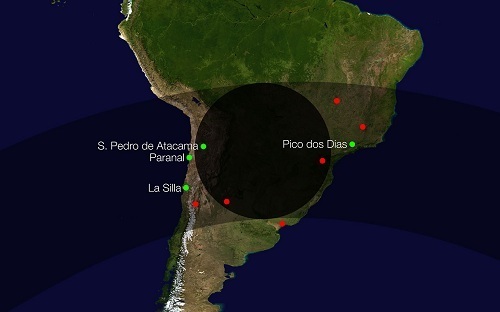
Image: This diagram shows the path of the shadow of the dwarf planet Makemake during an occultation of a faint star in April 2011. Several sites in South America, including ESO’s La Silla and Paranal Observatories, saw the star disappear briefly as its light was blocked by Makemake. This dwarf planet is about two thirds of the size of Pluto, and travels around the Sun in a distant path that lies beyond that of Pluto, but closer to the Sun than Eris, the most massive known dwarf planet in the Solar System. Makemake was expected to have an atmosphere like Pluto, but the new occultation data show that this is not the case. Credit: ESO/L. Calçada.
José Luis Ortiz (Instituto de Astrofísica de Andalucía, CSIC, Spain), who led this work, comments on its significance:
“As Makemake passed in front of the star and blocked it out, the star disappeared and reappeared very abruptly, rather than fading and brightening gradually. This means that the little dwarf planet has no significant atmosphere. It was thought that Makemake had a good chance of having developed an atmosphere — that it has no sign of one at all shows just how much we have yet to learn about these mysterious bodies. Finding out about Makemake’s properties for the first time is a big step forward in our study of the select club of icy dwarf planets.”
These observations, combined with earlier work, indicate that Makemake’s density is 1.7 ± 0.3 grams per cubic centimeter. From this, the team infers that the object is in the shape of a sphere somewhat flattened at the poles, with axes of 1430 ± 9 kilometres and 1502 ± 45 kilometres. This ESO news release offers more details.
The star occulted by Makemake was NOMAD 1181-0235723, with an event lasting no longer than a minute. In all, seven different telescopes across Brazil and Chile were used in the observations. The paper on this work is Ortiz et al., “Albedo and atmospheric constraints of dwarf planet Makemake from a stellar occultation,” Nature 491 (22 November 2012), pp. 566-569 (abstract).






November 21, 2012
Interstellar Propulsion Exotica
It was back in 1950 that Arthur C. Clarke looked at electromagnetic methods for getting a payload into space. The concept wasn’t new but Clarke’s paper in JBIS set out to examine what he saw as a practical use of it, an electromagnetic catapult on the lunar surface that could accelerate payloads back to Earth. The system was built around a three-kilometer long electromagnetic launcher that could accelerate payloads at 100 g’s to 2.3 kilometers per second (lunar escape velocity) in a matter of seconds. Gerald O’Neill thought such methods could deliver lunar raw materials to low Earth orbit for delivery to a space manufacturing site.

Clarke’s ideas played naturally into O’Neill’s, for building large space habitats requires vast amounts of raw materials that we’d just as soon not have to lift out of Earth’s gravity well. But Clarke’s thinking wasn’t restricted to near-Earth uses of the technology. He saw no necessary limit to the lengths and accelerations that could be used. Provide enough power to a space-based electromagnetic launcher and it could be configured to send robotic payloads to nearby stars. As with solar sails, we’re accelerating no propellant — only the payload — and that’s magic to any rocket scientist.
By the time E. H. Lemke looked at the idea in 1982, the size of such launchers had become astronomical. Lemke’s accelerator reached 108 kilometers in length, and used a solar collecting array hundreds of kilometers to the side to store the energy needed to boost payloads up to a third of lightspeed. Probes would be flung at 5000 g’s to nearby stars. It’s hard to see how a civilization capable of building on a scale like this (Lemke’s accelerator would be ⅔ of an astronomical unit long!) wouldn’t also have developed smaller and more efficient ways of sending probes on the same journey, but the same could be said for many giant sail concepts.
Clifford Singer’s work at Princeton on ‘pellet stream propulsion’ makes use of both Clarke and Lemke to arrive at a somewhat more adaptable idea. Writing in 1980, Singer proposed using a stream of electromagnetically charged pellets to transfer momentum to a departing interstellar craft. You can think in terms of a lightsail being pushed by a laser or microwave beam, but in this case the beam is composed of macroscopic pellets, each with a mass of several grams, being dispatched at 0.2 c to the starship, where they would impact and impart momentum.
At 105 kilometers in length, Singer’s electromagnetic launcher would be huge, though not on the scale of Lemke’s. In the original work, Singer emphasized that a system like this solved the collimation problem — the spread of the beam over distance — that would be faced by laser-beamed missions. His idea was to use several dozen stations, perhaps deployed by the starship itself, to measure pellet positions and send the needed commands to adjust their course at the launcher. He examined the question of dispersion due to the impact of interstellar dust grains along the route and concluded that pellets of 1 gram and up could be delivered to the starship with accuracy.
Later, Gerald Nordley would take the logical leap of ‘smart’ pellets, with enough technology aboard to adjust their course as required. Nordley’s ‘snowflake’ pellets would be built around nanotechnology and could find their own way to a starship that could itself make small changes in course if required to stay within the stream. And Jordin Kare subsequently produced ‘SailBeam,’ in which Singer’s pellets give way to tiny ‘micro-sails’ that can be accelerated to the departing starship and vaporized upon approach, becoming a plasma that drives the spacecraft.

Image: Jordin Kare’s ‘SailBeam’ concept. Credit: Jordin Kare/Dana G. Andrews.
SailBeam, which was a hybrid system crossing pellet propulsion with lightsails, also offered a major advantage. Kare’s studies demonstrated that you could accelerate a large number of small sails with a far less demanding optical system than required by a huge lightsail. The sails could also be accelerated much closer to their power source, which simplifies the problems of maintenance and sail deployment faced by a large sail under the beam for lengthy periods. Made of diamond film, Kare’s sails would accelerate to close to lightspeed within seconds.
So many concepts, so little time! Digging into interstellar exotica is a refreshing exercise that reminds me how many concepts have been kicked around in the literature. Most are grossly impractical given our level of technology, but the refining of some of them seen in Nordley and Kare’s work shows that we can at least nudge some of these notions in a more practical direction. Practical, that is, for a future with greater energy resources and wider options within the Solar System than we enjoy.
The original Arthur C. Clarke paper is “Electromagnetic Launching as a Major Contribution to Space-Flight,” JBIS 9 (6) (1950), pp. 261-267. It’s reprinted in Clarke’s Ascent to Orbit: A Scientific Autobiography (New York: John Wiley & Sons, 1984). The Lemke paper is “Magnetic Acceleration of Interstellar Probes,” JBIS 35 (1982), pp. 498-503. Cliff Singer’s first pellet paper is “Interstellar Propulsion Using a Pellet Stream for Momentum Transfer,” JBIS 33 (1980), pp. 107–115. And you can find Jordin Kare’s NIAC report “High-Acceleration Micro-Scale Laser Sails for Interstellar Propulsion,” (Final Report, NIAC Research Grant #07600-070, revised February 15, 2002) on the NIAC site.






November 20, 2012
More on the Starship ‘Slingshot’ Maneuver
Although we ordinarily think of Stanislaw Ulam in connection with pulse propulsion — and in particular with the Orion concept, in which nuclear devices are exploded behind the spacecraft — the scientist was also investigating other propulsion ideas. It puts yesterday’s discussion of Freeman Dyson’s ‘gravitational machines’ into context to realize that Ulam was writing about obtaining ‘a velocity arbitrarily large — that is, close to the velocity of light…’ using gravitational slingshots around astronomical objects in papers written as early as the late 1950s. There is, as Greg Matloff and Eugene Mallove remind us in The Starflight Handbook fantastic energy available in the orbital motion of celestial bodies. How best to tap it?
Michael Minovitch was already working at UCLA in the early 1960s on how to use a gravity ‘slingshot’ to affect spacecraft trajectories, thus extending the capacity for exploration. Dyson’s futuristic paper, as we saw yesterday, described gravitational machines involving white dwarfs and, quite presciently for the time, neutron stars back in 1963, just a few years after Ulam’s studies had concluded that gravitational maneuvers were possible but impractical for high velocities. One can easily object to Dyson’s thinking by asking how even an advanced civilization could manipulate neutron stars and, for that matter, how it might use such a transportation system. But Dyson’s thinking was aspirational. He wondered what might be possible for extraterrestrial cultures because this was a way of looking into possible human futures.
Matloff and Mallove quote Dyson on the matter: “There is nothing so big nor so crazy that one out of a million technological societies may not feel itself driven to do, provided it is physically possible.” It’s a thought that quickens speculation. And if we put our minds to it and run it through a science-fictional process of extrapolation, maybe a culture that already has interstellar travel would find it useful to have a kind of automated propulsion system that could routinely fling a payload out at almost 30 percent of the speed of light. Exactly how they might manage it and what their intentions would be will remain a mystery to a culture at our technological level.
A gravitational machine using neutron stars would subject the spacecraft using it to stupendous tidal forces, but a culture that can master neutron star engineering would perhaps find a way around these as well. In any case, in a time when we are thinking about ‘interstellar archaeology’ as a new mode for SETI, double star gravitational accelerators make one more possible artifact, or perhaps I should say, one more astronomical object near which we might look for signs of extraterrestrial engineering. A Kardashev Type II civilization might thus reveal its presence not in the form of a beamed radio or optical signal but rather through the works of its engineers.

But let’s get back closer to home. Yesterday I mentioned Krafft Ehricke’s own ideas on gravitational maneuvers in the form of a deep-space probe he thought could be accelerated to speeds that would make a mission to the inner Oort Cloud possible in a 50-year time-frame. In a 1983 paper in JBIS, Matloff and Mallove had initially confirmed Ehricke’s figures, assuming a close solar approach (to within 0.01 AU of the Sun’s center, or two solar radii) and factoring in no powered perihelion maneuver. But in a subsequent paper, Matloff went on to revise the numbers, finding what he calls a ‘subtle error’ in the original calculations.
Image: Interstellar theorist Gregory Matloff. Credit: CUNY.
Working with Kelly Parks, Matloff computed the velocities obtainable by a worldship falling toward the Sun and grazing the solar photosphere at 0.005 AU from the Sun’s center, with a 10 km/sec propulsive maneuver applied at perihelion. The result: “The hellish penetration of the solar atmosphere at 600 km/sec would occur in a relatively short but sizzling half-hour period. With the 10 km/sec maneuver, the starship would exit the Solar System with a hyperbolic excess velocity of 110 km/sec…” Doubling the perihelion maneuver to 20 km/sec gets you up to 156 km/sec as you exit. This is the sound of anti-climax, a nice bump up over Voyager-style speeds, but one that still leaves you with an Alpha Centauri crossing that takes close to 8000 years.
We can do better than this with a ‘Sun-diver’ maneuver involving solar sails, but that is a topic for another day. The paper is Matloff and Parks, “Interstellar Gravity Assist Propulsion,” JBIS 41 (November, 1988), pp. 519-526.






November 19, 2012
The Interstellar Gravitational Assist
While Rod Hyde, Lowell Wood and John Nuckolls were working on laser-induced fusion to drive a starship back in 1972, the range of options for advanced propulsion continued to grow. One we haven’t talked about much in these pages is the use of gravitational slingshots in exotic settings. We’re used to the concept within the Solar System because spacecraft like Voyager and Galileo have used a ‘slingshot’ around a planet to alter course and accelerate. But interstellar visionaries like Freeman Dyson have looked further out to imagine other uses for such techniques.
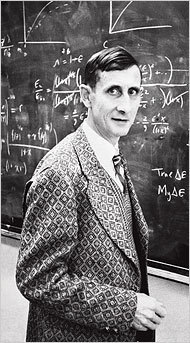
In a 1963 paper, Dyson speculated on how an advanced civilization might use a binary star system made up of two white dwarfs. Send a spacecraft into the system for a close pass around one of the stars and, depending on the mass and orbital velocity of the stars, it is thrown out of the binary system at velocities as high as 3000 kilometers per second. But Dyson took the idea even further. His paper, which appeared as a chapter in a book called Interstellar Communication (New York: Benjamin Press, 1963), described not just white dwarfs but the creation of a binary neutron star system as an engineered launch platform.
I can’t, in a quick search of the office this morning, find my copy of this book, but David Darling has the numbers in his Encyclopedia of Science. Two neutron stars, each with a diameter of 20 kilometers and a mass of one solar mass — and a combined orbital period of 0.005 seconds — would provide a departure velocity of 0.27 c, which works out to 81,000 kilometers per second. The concept has worked its way into the literature as the ‘Dyson slingshot,’ an artifact produced by an advanced civilization for flinging things from star to star. See Gregory Benford’s The Stars in Shroud (1978) for possible uses of such a system.
Image: Freeman Dyson pushed gravitational maneuvers to an extreme. Will future civilizations be able to manipulate neutron stars? Credit: New York Times
All this was in the air at a time when the very existence of neutron stars was in doubt (it would not be until five years later that Jocelyn Bell and Antony Hewish discovered the first radio pulsars, for which Hewish shared the Nobel Prize). Why get into all this in a book titled Interstellar Communication? Because Dyson also noted that a close binary system of neutron stars would decay in short order until the two components plunged into each other, creating a burst of gravitational waves that could be detected over millions of parsecs. Dyson thought it worth looking for events like this using some form of gravitational wave detection instrument.
But back to gravitational maneuvers to speed up spacecraft. Writing in the Journal of the British Interplanetary Society in 1972, German propulsion engineer Krafft Ehricke proposed using a gravitational slingshot to push a spacecraft out a tenth of a light year from the Sun. These days the plan would sound more familiar than it did when Ehricke wrote it: The probe would be sent first to Saturn for a propulsive maneuver as it moved behind the planet that would send it into a retrograde orbit, taking it near Jupiter for another slingshot toward the Sun.
Ehricke’s vehicle would close to within 1.6 million kilometers of the Sun, being flung around it and accelerated to 600 kilometers per second, which would take it to 6320 AU in 50 years. The engineer thought a mission like this could be useful as we learn about the interstellar medium and the outer system, but he believed 600 kilometers per second was about as much as he could wring out of the method. Actual interstellar missions would need breakthroughs of the kind Hyde, Wood and Nuckolls were examining at Lawrence Livermore, or perhaps antimatter.
I’m not clear on whether Ehricke was aware of the 1960s work of Robert Forward, George Marx (Roland Eötvös University, Hungary) and J.L. Redding (Bishop’s University, Quebec) on laser beaming to large space-based sails, but I haven’t yet found any reference to it in his work. He did, however, develop expansive ideas about our species’ role in the cosmos that I’ll be looking at shortly.
The Dyson paper is “Gravitational Machines,” in A.G.W. Cameron, ed., Interstellar Communication, New York: Benjamin Press, 1963, Chapter 12. Krafft Ehricke’s paper on gravitational assist is “Saturn-Jupiter Rebound: A Method of High-Speed Ejection from the Solar System,” JBIS 25:10 (October, 1972), p. 561.






November 16, 2012
Conceiving the Laser-Fusion Starship
When young Rod Hyde, fresh out of MIT, started working on starship design in mid-1972, there were not many fusion-based precedents for what he was up to. He had taken a summer job that would turn into a career at Lawrence Livermore National Laboratory, but right off the bat he was involved with Lowell Wood and John Nuckolls in a concept that would use a battery of lasers to create fusion reactions whose energy would be channeled out the back of the ship by magnetic nozzles. Wood and Nuckolls had been developing their ideas for years, after Nuckolls first began to ponder how to use laser fusion micro-explosions to drive a spacecraft.
Now the duo had a kid who had spent his previous summers working in a beet cannery, a recruit for Livermore who had run up high grades at MIT and had shown he could work like a demon once he put his mind to it. This would be his first technical job. Hyde went into full gear on containing the plasma from the fusion explosions with a magnetic field. If they could ignite fusion, the three researchers were looking at specific impulses of 300,000 seconds and maybe as high as a million.
The figure was staggering. The amount of time it takes one pound of fuel to produce one continual pound of thrust gives you the specific impulse figure. It’s one way to measure rocket performance. Putting the work of Hyde, Wood and Nuckolls in context, consider that the main engines of the Space Shuttle can turn out a specific impulse of about 455 seconds. Hyde couldn’t talk about the specifics of the fusion pellets and laser ignition in this engine when he presented it in late 1972 at a conference of the American Institute of Aeronautics and Astronautics in New Orleans, but even the declassified version made quite a splash.
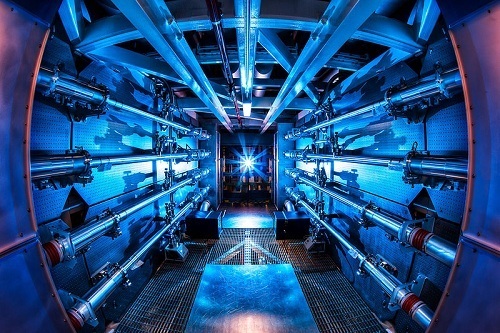
Image: We’re still trying to turn fusion into a reliable power source here on Earth. Pictured are the pre-amplifiers of the National Ignition Facility at LNLL. Will we ever find a way to use inertial confinement fusion powered by lasers on a spacecraft? Credit: Damien Jemison/LLNL.
A Memorable Conference
Remember, this was shortly before Daedalus, the British Interplanetary Society’s starship design project that began in 1973. Daedalus would go on to develop a concept around inertial confinement fusion ideas produced by Friedwardt Winterberg, a theoretical physicist at the University of Nevada in Reno. In later years, Hyde would question some of the Daedalus work, about which more in a moment. For now, let me quote Thomas Heppenheimer, who wrote about the New Orleans conference and the starship design in his book The Man-Made Sun (Little Brown, 1984). Heppenheimer says the paper took the conference by storm:
Hyde stood up there at the podium and laid it all out: the physics, the design concepts, the calculations, the performance equations. Almost nobody in the audience had the background to follow him. Still, the paper was a blockbuster, for it had about it the aura of classified technology. People didn’t know much in those days about laser fusion, though it was considered quite a hot topic, but nobody could say why. Also, the word got around that Wood had had a hard time getting the paper cleared through classification so that it could be released. The government had just barely, and reluctantly, let it out. Then the requests for copies of the paper started pouring in.
And pour in they did. Wood had ordered two hundred reprints and surely thought he had grossly overestimated the demand, but the papers were gone in two months and the starship designers were sending out copies from the lab’s copy machines. The 19-year old Hyde found his paper being sought out by the White House and the National Security Council. Hyde would go on to develop a much longer report based on the paper, spending the ensuing years developing how the laser would work and covering details from radiation shielding to power equipment.
Radiators and Starship Design
Yesterday I ran an image from the film Avatar to accompany the first of these articles on Hyde, Wood and Nuckolls’ ideas. The choice was deliberate because the ISV Venture Star has what many cinematic starships lack: A set of radiators. Think about the fact that while a rocket of any kind will produce heat, a vehicle like the Space Shuttle is also cooled by the flow of hydrogen fuel (over 440 pounds of hydrogen per second). Fusion engines can’t shed their heat as readily. They demand radiators that will glow red-hot as they carry the heat away. Hyde saw this early in the game and spent a lot of time working on the radiators and their supporting equipment.
The engine design that Hyde took to New Orleans was based on inertial confinement fusion as conceived by Wood and Nuckolls, a concept intended to move far beyond Orion, with its nuclear devices exploded behind the spacecraft to drive it forward. The new design would use frozen pellets of deuterium/tritium, each weighing 0.015 grams, 500 of which would be exploded by lasers every second. The result would be a tiny fireball whose charged particles would be turned into the exhaust beam by magnetic coils. The fireball would in turn press the magnetic field to induce current in a pickup coil, flowing into a capacitor whose discharge would fire the lasers.
When Hyde later looked at the Daedalus papers, developed not long after his initial work with Wood and Nuckolls, he balked over the issue of the fuel pellets, thinking that the design was unworkable. The Daedalus designers had based their pellet design on unclassified literature, but Hyde knew there was a great deal more about pellet design than could be reported in the press. When he ran the BIS’ pellets through the LASNEX computer code then in use at Livermore, he found they produced little thrust, and if re-engineered to create thrust, would melt the engine.
With breakeven fusion proving a tougher nut to crack than appeared likely in the 1970s, it’s almost wistful to look back at some of the excitement these methods produced in that era. Thomas Heppenheimer talked of using the Hyde/Wood/Nuckolls design to boost a spacecraft to ten percent of the speed of light for a flyby mission to a nearby star, diverting to another after the first encounter. A probe to Barnard’s Star, for example, would reach its target in 64 years, after which it would be re-deployed toward 70 Ophiuchi, which it would reach some 92 years later.
Today we’re re-examining the whole concept of inertial confinement fusion, with ongoing work at the National Ignition Facility located at Livermore. In starship terms, the Icarus project is massaging the Daedalus report to bring it up to speed with current thinking and technology, even as the question of flyby probes is giving way to a realization that without a means of decelerating, we’ve spent vast amounts of money on mere hours of close-in data. Whether the intense work that resulted in Hyde’s final designs will ever pay off in terms of an actual mission to a star remains to be seen, but the ideas he worked with at Livermore continue to be a vital part of interstellar studies, energizing continued work on the conundrum of fusion propulsion.
For more on all this, the original conference paper is Hyde, Wood and Nuckolls, “Prospects for Rocket Propulsion with Laser Initiated Fusion Microexplosions.” AIAA Paper 72-1063, American Institute of Aeronautics and Astronautics, November 1972.






November 15, 2012
Starship Design: Rod Hyde, Reykjavik and Chess
Growing up in Corvallis, Oregon, math prodigy and future weapons designer Rod Hyde seemed to have two things on his mind: chess and science fiction. Gordon Dickson, Keith Laumer and Robert Heinlein had fed his adolescence with images of man’s future in space, and by the time he was interviewed by the New York Times’ William Broad for a book called Star Warriors (1985), he was talking about getting humans off the planet as a means of species survival. Rod was at Lawrence Livermore National Laboratory then, deep in the world of nuclear weapons design and the ideas that would emerge as ‘Star Wars.’
Not the movie, of course, but the Reagan-era defensive shield that would, it was hoped, bring down incoming missiles and forever alter the balance of power. As anti-Soviet as they come, Hyde always took the long-range view when the conversation moved to the future. He tells Broad:
“What I want more than anything is essentially to get the human race into space. It’s the future. If you stay down here some disaster is going to strike and you’re going to be wiped. If you get into space and spread out there’s just no chance of the human race disappearing.”

I was thinking about all this today because last night I gave a talk on interstellar mission concepts and discussed species survival as a driver for building up the space-based infrastructure that might eventually make them possible. But I also thought about the young Rod Hyde because I was once, totally without my knowing it, in the same venue with him in Reykjavik, Iceland. Back in 1972, Bobby Fischer went to Reykjavik to take on Russia’s Boris Spassky in a world championship chess match. I was in Reykjavik because I was studying Old Norse, the language of the Vikings, and the direct ancestor of modern Icelandic. Hyde was there for the chess.
Image: Bobby Fischer (right) shoots Boris Spassky a glance as the latter mulls his position in 1972′s world chess championship. Credit: Morgunblaðið.
Now Reykjavik is a small place, back then about 80,000, and when I wasn’t in the museums or the incredibly numerous bookstores, I went to as many of the chess matches as I could, where Fischer put on his usual antics, like showing up after the clock had already started and swooping in with affected nonchalance to make his opening move. A chess championship at that level is a bit surreal. No one dared to make a sound, and if even a rustle of whispering broke out in the audience, the Icelandic word þögn! (silence) would instantly appear on the screen above the players. Because long thought went into each move, watching the match mostly involved being perfectly still and waiting for something to happen.
The crowd loved it. Icelanders love chess anyway, doubtless the result of long indoor hours during the dark winter, which also explains the ubiquitous bookshops. They would sit in silence for long minutes until one of the players made a move. Then nods would break out, or perhaps a sigh. Sometimes the move was dramatic, and then a collective gasp would go up as Spassky or Fischer seemed to get the edge. I would see people glancing at each other in puzzlement or approval and resolved to learn how to play chess better, a promise I never really kept.
I bet Hyde had the time of his life. The Reykjavik championship had come just at the time when his designs for a starship had reached completion. Back in 1972, Rod had finished up at MIT and, when not playing in chess tournaments of his own, had begun to look for graduate fellowships. The search led to an offer of a summer job working on laser fusion rockets with Livermore’s Lowell Wood. The 19-year old thus went to work at the weapons lab and in his head were already the designs for a starship engine that would put out power like no engine ever had. He had fusion in mind, and his thoughts had been influenced by laser developments.

Image: The ISV Venture Star, from James Cameron’s film Avatar. Note the radiators, about which more tomorrow. Credit: Lightstorm Entertainment/20th Century Fox.
Broad tells the story: Rod was transfixed by the starship idea but, as a huge fan of Fischer’s, determined to be in Reykjavik for the chess championship. He began working long days and into the night pounding on the design, at one point locking himself in his office for four straight days to produce a final paper that would later be presented at a conference in New Orleans. Broad says that Lowell Wood led the sleep-deprived Hyde out to his car to take him to the airport for the Iceland flight, and we can only hope that he somehow got a bit of sleep on the plane. I doubt it, though, because in those days going to Iceland involved an aged DC-8 with cramped seats, a noisy cabin, and usually a full passenger manifest. I lost a lot of sleep on those crossings.
But Hyde was a genuine workaholic. I’ve already mentioned his youth when he received his undergraduate degree, and once he began at Livermore, he split time between the lab and MIT as he went on to receive an M.S. in 1973 and, now working full-time at Livermore, a doctorate in 1976. He was contemptuous of Soviet rocket design and deeply distrustful of Soviet intentions, but underlying all the personal geopolitics was the idea of space as a solution to human problems. Broad quotes him in the course of a long interview on the political situation of the time:
“I want the future to be up in space because there is just so much more out there… Here you can’t play games with new political systems because every piece of land is already owned by someone. It’s a zero-sum game. Out there, it’s absolutely limitless. There’re no more frontiers here. Space is one big frontier.”
Thus Rod’s membership in the Citizens Advisory Council on National Space Policy, which science fiction writer Jerry Pournelle had founded, and which was sponsored by both the American Astronautical Society and the L-5 Society. And thus his obsession with going to the stars, which obviously grew out of a childhood steeped in science fiction coupled with a mathematical and engineering bent that led him to seek new solutions. Tomorrow I want to talk a bit more about Hyde and the starship ideas that would emerge from this restless polymath.






Paul Gilster's Blog
- Paul Gilster's profile
- 7 followers


